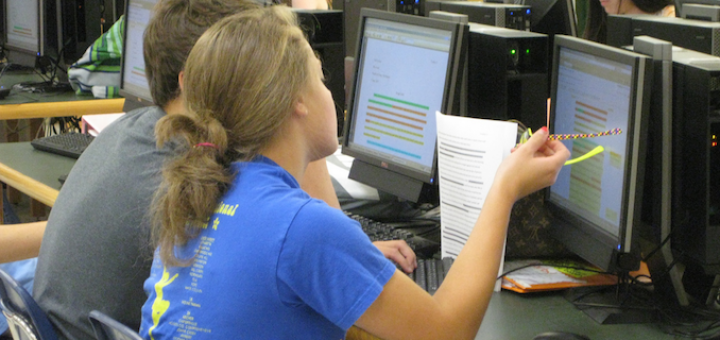By Jason D. DeHart
 Why do we read and write in the first place? Why should our students care about sharpening their literacy skills? This article poses these questions and explores the importance of maintaining multiple avenues for students to respond daily when they are reading and writing across content areas.
Why do we read and write in the first place? Why should our students care about sharpening their literacy skills? This article poses these questions and explores the importance of maintaining multiple avenues for students to respond daily when they are reading and writing across content areas.
Responding
Reading should always lead to responding in some way, even if that response is limited to telling someone what you know about a book that you love. This is, perhaps, the most-used way of responding beyond the walls of a classroom. Readers become advocates for the books they enjoy most.
Frank Serafini has written about the multitude of activities that schools apply to books – making dioramas and mobiles, for example. Such creation can even be done instead of reading at times. As we continue to guard reading as sacred practice in middle grades, we must also keep the responses that students share about their reading at the forefront of our attention.
“How long does it have to be?”
It’s a fair question. It is worth noting that having students respond to a text in writing does not need to be a lengthy multiple-day process, nor we should we feel obligated to respond to all aspects of student writing. Getting students to engage in the process of writing each day is the key, and the volume can add up over time.
Daily writing can be a meaningful back channel between teachers and students. Sometimes we can respond to readers with grammatical recommendations (see my previous post on this), suggestions for more focused meaning-making, or even a general “I see you” or “I see what you did there” kind of feedback loop. Not all teacher feedback needs to be done exactly the same way or focus on the same purpose – there is room for creativity in this part of the writing process, as well.
The important element is that we create space and time, even if it isn’t very much space and time, and allow the opportunities for responding to be part of our routines. In fact, it is my supposition that including daily writing in this way will help teachers more deeply explore concepts (even standards) than they could without including writing and responding.
Thinking Partners and Building Partners
Writing is a solitary engagement for many professionals in the field. Many authors I have interviewed talk about the exile-like nature of the work and the need for find ways to recharge. In the case of students, we can help balance the isolation of writing with the community of voices in our classrooms.
To break through the isolation, students can engage in brainstorming processes with other students, asking for specific feedback from thought partners and exploring possible ideas. And teachers can lead students through a series of “what if” questions to help them reconsider their drafting and shore up their responses. These kinds of reread and revisit activities hint at the revision process that is an essential practice in writing.

There is a time for writers to be immersed in the solitude of creativity, but the loop of feedback from teachers and other students can begin at the very first line. If a student has trouble filling up a blank page, they can reach out for support in starting and then continue the narrative in the way that feels most authentic to them.
When modeling writing, I often read aloud my own writing from a text I have just shared with students. In almost every case, I find something that I can improve on. Reading aloud and thinking aloud about my own reactions to my writing models the process of fine-tuning – and dispels the idea that perfection is needed on the first draft or even the drafts that come after that.
Engaging with Authors and Voices
I believe that part of the reason we choose to write is to build community, even if that connection happens across geography, time, or mortality. I can connect with the experiences of someone in the past who has insights into parts of life that can either be helpful to me or simply point me in a healthy direction.
Recently I was teaching a fiction workshop series and it occurred to me that it is the reader who brings a sense of reality to the author’s fictional characters and setting, The writer is a real person who imagines the unreal, then casts this vision into the hands of the reader. Without that reader, the writer’s work of imagination withers.
Even if we can devote only a few minutes in class each day to centering mentor texts, that time will be well worth it. This is no less true in content areas outside of English/Language Arts – exploring authentic primary texts that relate to the content we’re teaching need not be lengthy and laborious but can help spark interest in the topic and underscore the value of reading and writing.
Authors can visit classrooms in person, virtually, or through their autobiographical writing, and teachers can think about the aspects of the author’s writing (e.g., dialogue, description, character voice) that they want to encourage students to develop with well-chosen mentor texts.
Writing is, indeed, a process, and I am always eager to try new steps to help demystify the work involved and de-emphasize the myth of storytelling perfection in the first draft.
Questions for Reflection
►How do we help students see the value of their stories?
►How can we do all that we need to and still make time and space for storytelling and writing?
►What makes stories so meaningful in the first place – and how do we tap into that energy for classroom interactions?
Dr. Jason D. DeHart teaches English at Wilkes Central High School in Wilkesboro, North Carolina. He taught English Language Arts to middle grades students in Cleveland, Tennessee for eight years, earned his doctorate, and served as an assistant professor of reading education at Appalachian State University before returning to his first love, the secondary classroom.
Jason’s work has appeared in Edutopia, SIGNAL Journal, English Journal, The Social Studies, and the NCTE Blog. See all of Jason’s MiddleWeb posts here – including a 3-part series with teacher and school librarian Jennifer Sniadecki on using picture books with middle level readers. His website Book Love: Dr. J. Reads offers book reviews and author interviews.







